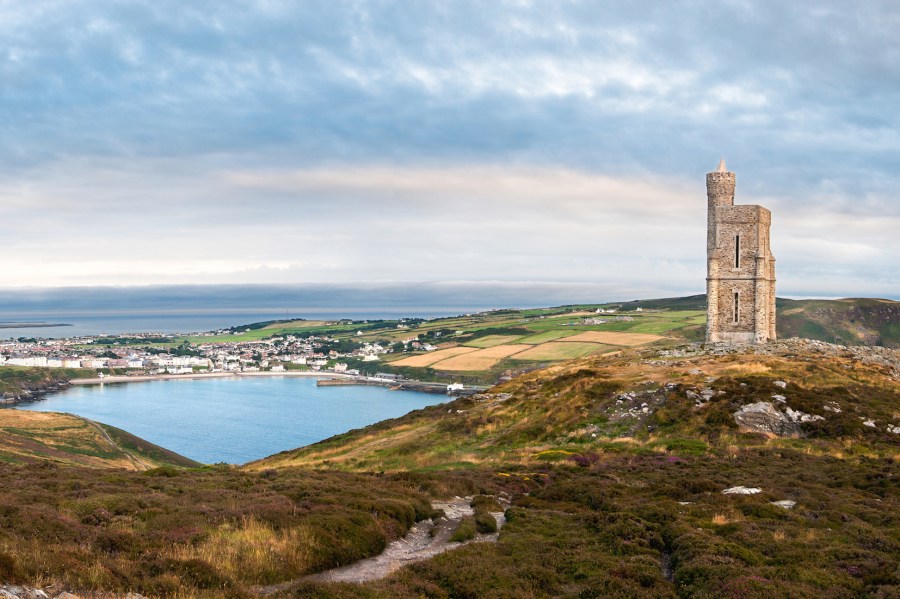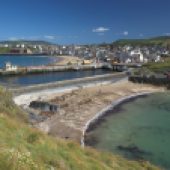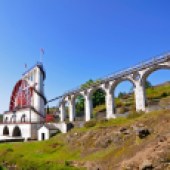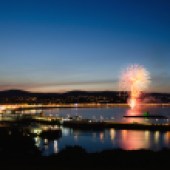With its scenic coastal paths, ancient castles and maritime history, this beautiful island in the Irish Sea makes for a memorable mini-break. Words: Lesley Gillilan
The Isle of Man is best known for TT motor racing, cats without tails and a curious three-legged symbol on a scarlet national flag. But among fellow Brits, it’s still a bit of a mystery; some of us don’t even know where it is. A pity, because this Irish Sea island –which, incidentally, lies roughly 80 miles northwest of Liverpool – has so much to offer.
Measuring 32 miles end to end, it’s often described as ‘Britain in miniature’ and in many ways, it’s a chip off the old block. There are wild, heathery uplands reminiscent of English moorland; high rocky cliffs with a whiff of West Cornwall. Glens and tartans add a flavour of Scotland. The local accent is borrowed, it seems, from Merseyside. And the weather – notoriously unpredictable – seems to wash in from Ireland. But this British Crown dependency has its own distinct Manx character.
A self-governing kingdom with a parliament established by the Vikings over a thousand years ago, the Isle of Man (or Ellen Vannin) has its own language and its own currency (though sterling is accepted everywhere). Specialities include heritage railways and ancient castles, kippers and ‘queenies’ (small, sweet Manx scallops), wildlife walks, fresh clean air and a fascinating maritime history. In March, the island’s museums and attractions begin to open for the summer, but outside of the madly busy motor-racing season in June, you can often have much of the island all to yourself.
SATURDAY AM
10AM ALL STEAMED UP
On the footplate of a Victorian steam engine, I am dressed in a borrowed boiler suit and, with one hand working the throttle or ‘regulator’, I am in the driver’s seat. ‘Ease her slowly into the station,’ my instructor tells me as we chuff into Port St Mary, in the far south of the island. This is my taste of the Ultimate Driving Experience, a rail-buff’s dream served up by the Isle of Man Steam Railway. One of the oldest, surviving narrow-gauge railways in Britain, its vintage engines have been travelling from Douglas to Port St Mary since 1873. And whether a driver or a passenger, the 15 mile trip, is a great introduction to the scenery of Man’s ‘Beautiful South’, where we have chosen to spend our Manx weekend.
SATURDAY PM
1PM BEACHES AND CREAM
In Port St Mary, my husband and I stroll along the seafront, past pastel-painted cottages and a quaint little harbour, before picking up a picnic hamper from the family-run Patchwork Café. On nearby Chapel Beach, we spread out the hamper’s Manx tartan rug along with a feast of artisan bread, hay-baked chicken, cheeses from the Isle of Manx Creamery (run by a co-operative of small island dairy farms), homemade cakes and fruit scones served with little tubs of jam and cream. You’ll find the same goodies in the café’s ‘yompnic’, a rucksack-friendly takeaway for walkers.
3PM CASTLE, KEYS AND OLD SEADOGS
It takes us 10 minutes to drive to Castletown, the island’s ancient capital where the magnificent Castle Rushen towers over its narrow streets and salty harbour. Built in 1265, and one of the world’s best-preserved medieval fortresses, the castle is all rugged limestone, dimly-lit chambers, tapestries and tales of Nordic Kings and Manx Lords. We explore the dungeons, the kitchens and the banqueting hall, but the best bit is the view from the ramparts (the town, the sea and miles of southern coast).
On the streets below, we just have time to visit the House of Keys (the Manx seat of parliament until 1874) and the tiny Nautical Museum. In this seaside cottage, the former home of Captain George Quayle, we see the cabin room – decked out like a naval warship – and a boat cellar where we meet Peggy, the world’s oldest surviving yacht.
7PM SEASIDE STROLLS AND WATERFRONT DINING
In Douglas, the island’s town-like capital, we scoot along its two-mile seaside promenades – a great sweep of grand terraces, palm trees and, in high season, horse-drawn trams. For dinner, we choose 14 North, a converted 19th-century merchant’s house on nearby North Quay, which has modern-rustic interiors, views of the harbour and a passion for Manx produce. I start with queenies cooked with pesto and Parmesan followed by a roasted fillet of hake with fresh vegetables. Even the bottled water (from Green Mann Spring) is local.
SUNDAY AM
9AM WALK ON THE WILDSIDE
After breakfast at the Arches B&B in Port Erin – a charming Victorian resort town – we start a three-mile hike along the Raad ny Foillan. We enjoy dramatic views from high cliffs, the odd glimpse of marine life and, finally, the Sound of Calf, the narrow sea channel which divides Man’s southern tip from the Isle of Calf. Over a warming cup of tea, we take in the views from the Sound of Man Visitor Centre, a circular glass building which leans into the headland under a turfed roof. Then we head uphill to Cregneash, the living village of crofters cottages, cattle, plough horses and farm buildings which make up this isolated National Folk Museum. In summer, you can explore the cottages and see thatching and weaving demos. For now, we simply enjoy the scenery, the cooling wind and the cluck of chickens.
SUNDAY PM
1PM KIPPERS AND CORNETS
In Peel, on the island’s west coast, we lunch at the Creek Inn, a fishing-harbour pub offering hearty food and a warm welcome. On the menu we find fresh Manx crab, Peel kippers and locally caught seabass, but we opt for a filling bowl of chowder with haddock, prawns and queenies in a rich white sauce washed down with a pint of Okell’s, an island-brewed real ale. We skip pudding to leave room for a scoop or two of Manx ice cream from Davison’s Parlour on Peel Promenade. The long list of unusual flavours includes Apple Pie, Jelly Bean, Ketchup and, of course, Kipper.
2PM STEP BACK IN TIME
Among the kipper sheds on Peel’s quay, the House of Manannan (named after a mythological seagod) takes you on a journey through the island’s seafaring past. With life-size replicas, voices, smells and lots of buttons to press, this colourful museum could easily take up an afternoon, but we whizz through the highlights – a recreation of a Celtic roundhouse, a Viking longship, the story of a Manx crewman on the doomed HMS Bounty – leaving time to visit Peel Castle. On St Patrick’s Isle, right by the harbour, this is the ruined but dramatic shell of the fort of Magnus Barefoot – an 11th-century Viking King. Inside the walls, we climb the gatehouse tower for spectacular views of Peel Bay.
5PM TOTAL SECLUSION
On the drive back to Port Erin, we stop off at Niarbyl. This rocky bay has a visitor centre, a scatter of thatched fishermen’s cottages, and a tail of rocks jutting into the Irish Sea (niarbyl means ‘the tail’). From here, we do a final coast-path walk, to one of Man’s many, tiny secluded beaches. Not a soul in sight; just us and the gulls and the roar of the sea. Isle of Man magic.
Stay at…
THE ARCHES BOUTIQUE B&B
This modern retreat has floor-to-ceiling windows and private balconies. There’s a circular glass lounge, neon lights and a spa with heated pool. Home-cooked dinners are available on request. Doubles from £90 bedandbreakfast-isleofman.com.
LANGNESS LIGHTHOUSE COTTAGES
On a narrow peninsula close to Castletown, these two cottages, East and West, offer bright, airy self-catering accommodation for up to four people. From £600 a week isle-of-man-holiday.com
HOW TO GET THERE
Flybe operates flights to Ronaldsay from 20 British airports, including London Gatwick, Liverpool, Edinburgh, Birmingham, Bristol and Exeter. Ferries run by the Isle of Man Steam Packet sail to Douglas from Heysham or Liverpool in three hours. To find out more on the area go to visitisleofman.com
With its scenic coastal paths, ancient castles and maritime history, this beautiful island in the Irish Sea makes for a memorable mini-break. Words: Lesley Gillilan
The Isle of Man is best known for TT motor racing, cats without tails and a curious three-legged symbol on a scarlet national flag. But among fellow Brits, it’s still a bit of a mystery; some of us don’t even know where it is. A pity, because this Irish Sea island –which, incidentally, lies roughly 80 miles northwest of Liverpool – has so much to offer.
Measuring 32 miles end to end, it’s often described as ‘Britain in miniature’ and in many ways, it’s a chip off the old block. There are wild, heathery uplands reminiscent of English moorland; high rocky cliffs with a whiff of West Cornwall. Glens and tartans add a flavour of Scotland. The local accent is borrowed, it seems, from Merseyside. And the weather – notoriously unpredictable – seems to wash in from Ireland. But this British Crown dependency has its own distinct Manx character.
A self-governing kingdom with a parliament established by the Vikings over a thousand years ago, the Isle of Man (or Ellen Vannin) has its own language and its own currency (though sterling is accepted everywhere). Specialities include heritage railways and ancient castles, kippers and ‘queenies’ (small, sweet Manx scallops), wildlife walks, fresh clean air and a fascinating maritime history. In March, the island’s museums and attractions begin to open for the summer, but outside of the madly busy motor-racing season in June, you can often have much of the island all to yourself.
SATURDAY AM
10AM ALL STEAMED UP
On the footplate of a Victorian steam engine, I am dressed in a borrowed boiler suit and, with one hand working the throttle or ‘regulator’, I am in the driver’s seat. ‘Ease her slowly into the station,’ my instructor tells me as we chuff into Port St Mary, in the far south of the island. This is my taste of the Ultimate Driving Experience, a rail-buff’s dream served up by the Isle of Man Steam Railway. One of the oldest, surviving narrow-gauge railways in Britain, its vintage engines have been travelling from Douglas to Port St Mary since 1873. And whether a driver or a passenger, the 15 mile trip, is a great introduction to the scenery of Man’s ‘Beautiful South’, where we have chosen to spend our Manx weekend.
SATURDAY PM
1PM BEACHES AND CREAM
In Port St Mary, my husband and I stroll along the seafront, past pastel-painted cottages and a quaint little harbour, before picking up a picnic hamper from the family-run Patchwork Café. On nearby Chapel Beach, we spread out the hamper’s Manx tartan rug along with a feast of artisan bread, hay-baked chicken, cheeses from the Isle of Manx Creamery (run by a co-operative of small island dairy farms), homemade cakes and fruit scones served with little tubs of jam and cream. You’ll find the same goodies in the café’s ‘yompnic’, a rucksack-friendly takeaway for walkers.
3PM CASTLE, KEYS AND OLD SEADOGS
It takes us 10 minutes to drive to Castletown, the island’s ancient capital where the magnificent Castle Rushen towers over its narrow streets and salty harbour. Built in 1265, and one of the world’s best-preserved medieval fortresses, the castle is all rugged limestone, dimly-lit chambers, tapestries and tales of Nordic Kings and Manx Lords. We explore the dungeons, the kitchens and the banqueting hall, but the best bit is the view from the ramparts (the town, the sea and miles of southern coast).
On the streets below, we just have time to visit the House of Keys (the Manx seat of parliament until 1874) and the tiny Nautical Museum. In this seaside cottage, the former home of Captain George Quayle, we see the cabin room – decked out like a naval warship – and a boat cellar where we meet Peggy, the world’s oldest surviving yacht.
7PM SEASIDE STROLLS AND WATERFRONT DINING
In Douglas, the island’s town-like capital, we scoot along its two-mile seaside promenades – a great sweep of grand terraces, palm trees and, in high season, horse-drawn trams. For dinner, we choose 14 North, a converted 19th-century merchant’s house on nearby North Quay, which has modern-rustic interiors, views of the harbour and a passion for Manx produce. I start with queenies cooked with pesto and Parmesan followed by a roasted fillet of hake with fresh vegetables. Even the bottled water (from Green Mann Spring) is local.
SUNDAY AM
9AM WALK ON THE WILDSIDE
After breakfast at the Arches B&B in Port Erin – a charming Victorian resort town – we start a three-mile hike along the Raad ny Foillan. We enjoy dramatic views from high cliffs, the odd glimpse of marine life and, finally, the Sound of Calf, the narrow sea channel which divides Man’s southern tip from the Isle of Calf. Over a warming cup of tea, we take in the views from the Sound of Man Visitor Centre, a circular glass building which leans into the headland under a turfed roof. Then we head uphill to Cregneash, the living village of crofters cottages, cattle, plough horses and farm buildings which make up this isolated National Folk Museum. In summer, you can explore the cottages and see thatching and weaving demos. For now, we simply enjoy the scenery, the cooling wind and the cluck of chickens.
SUNDAY PM
1PM KIPPERS AND CORNETS
In Peel, on the island’s west coast, we lunch at the Creek Inn, a fishing-harbour pub offering hearty food and a warm welcome. On the menu we find fresh Manx crab, Peel kippers and locally caught seabass, but we opt for a filling bowl of chowder with haddock, prawns and queenies in a rich white sauce washed down with a pint of Okell’s, an island-brewed real ale. We skip pudding to leave room for a scoop or two of Manx ice cream from Davison’s Parlour on Peel Promenade. The long list of unusual flavours includes Apple Pie, Jelly Bean, Ketchup and, of course, Kipper.
2PM STEP BACK IN TIME
Among the kipper sheds on Peel’s quay, the House of Manannan (named after a mythological seagod) takes you on a journey through the island’s seafaring past. With life-size replicas, voices, smells and lots of buttons to press, this colourful museum could easily take up an afternoon, but we whizz through the highlights – a recreation of a Celtic roundhouse, a Viking longship, the story of a Manx crewman on the doomed HMS Bounty – leaving time to visit Peel Castle. On St Patrick’s Isle, right by the harbour, this is the ruined but dramatic shell of the fort of Magnus Barefoot – an 11th-century Viking King. Inside the walls, we climb the gatehouse tower for spectacular views of Peel Bay.
5PM TOTAL SECLUSION
On the drive back to Port Erin, we stop off at Niarbyl. This rocky bay has a visitor centre, a scatter of thatched fishermen’s cottages, and a tail of rocks jutting into the Irish Sea (niarbyl means ‘the tail’). From here, we do a final coast-path walk, to one of Man’s many, tiny secluded beaches. Not a soul in sight; just us and the gulls and the roar of the sea. Isle of Man magic.
Stay at…
THE ARCHES BOUTIQUE B&B
This modern retreat has floor-to-ceiling windows and private balconies. There’s a circular glass lounge, neon lights and a spa with heated pool. Home-cooked dinners are available on request. Doubles from £90 bedandbreakfast-isleofman.com.
LANGNESS LIGHTHOUSE COTTAGES
On a narrow peninsula close to Castletown, these two cottages, East and West, offer bright, airy self-catering accommodation for up to four people. From £600 a week isle-of-man-holiday.com
HOW TO GET THERE
Flybe operates flights to Ronaldsay from 20 British airports, including London Gatwick, Liverpool, Edinburgh, Birmingham, Bristol and Exeter. Ferries run by the Isle of Man Steam Packet sail to Douglas from Heysham or Liverpool in three hours. To find out more on the area go to visitisleofman.com










